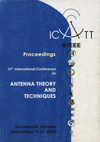Investigation of integral equation for dielectric-coated thin-wire conductors
DOI:
https://doi.org/10.1109/ICATT.2003.1238847Keywords:
thin-wire conductor, dielectric, integral equation, equation kernel, method of momentsAbstract
There is a wide class of antennas that can be presented as a set of thin-wire perfect conductors. Current distribution, radiation and scattering problems are usually solved by the method of integral equations (IE). While using antennas, there is the possibility of the formation of different kinds of coating, for instance, ice, that can be approximated by an ideal dielectric. In that case, a model of a system of dielectric-coated thin-wire conductors is used. Numerical analysis of an integral equation based on Pocklington's equation for dielectric-coated thin-wire conductors is given. To obtain solution stability, recommendations are offered for choosing a segment length depending on dielectric layer permittivity and thickness.References
Mittra, R. Numerical methods in electrodynamics. M.: Mir, 1977, 485 p. [in Russian].
Popovich, B.D.; Djordjevich, A.R.; Kirchanski, N.M. Simple method for analysis of dielectric-coated wire antennas. The radio and Electronic Engineer, 1981, Vol. 51, No. 3, p. 141-145.
Demidchik, V.I. Integral equation for thin-wire conductors with dielectric coating. Vestn. Belarus. univ. Ser. 1, 2000, No. 3, p. 29-31.
Fletcher, K. Numerical methods based on Galerkin’s method. M.: Mir, 1988, 352 p. [in Russian].
Demidchik, V.I.; Kalashnikov, N.V.; Runov, A.V. A calculation algorithm for current distribution of long-electric curvilinear conductors. Izv. Vuzov. Radioelektronika, 1983, Vol. 26, No. 3, p. 82-84.
Published
2003-09-28
Issue
Section
Analytical and numerical techniques

